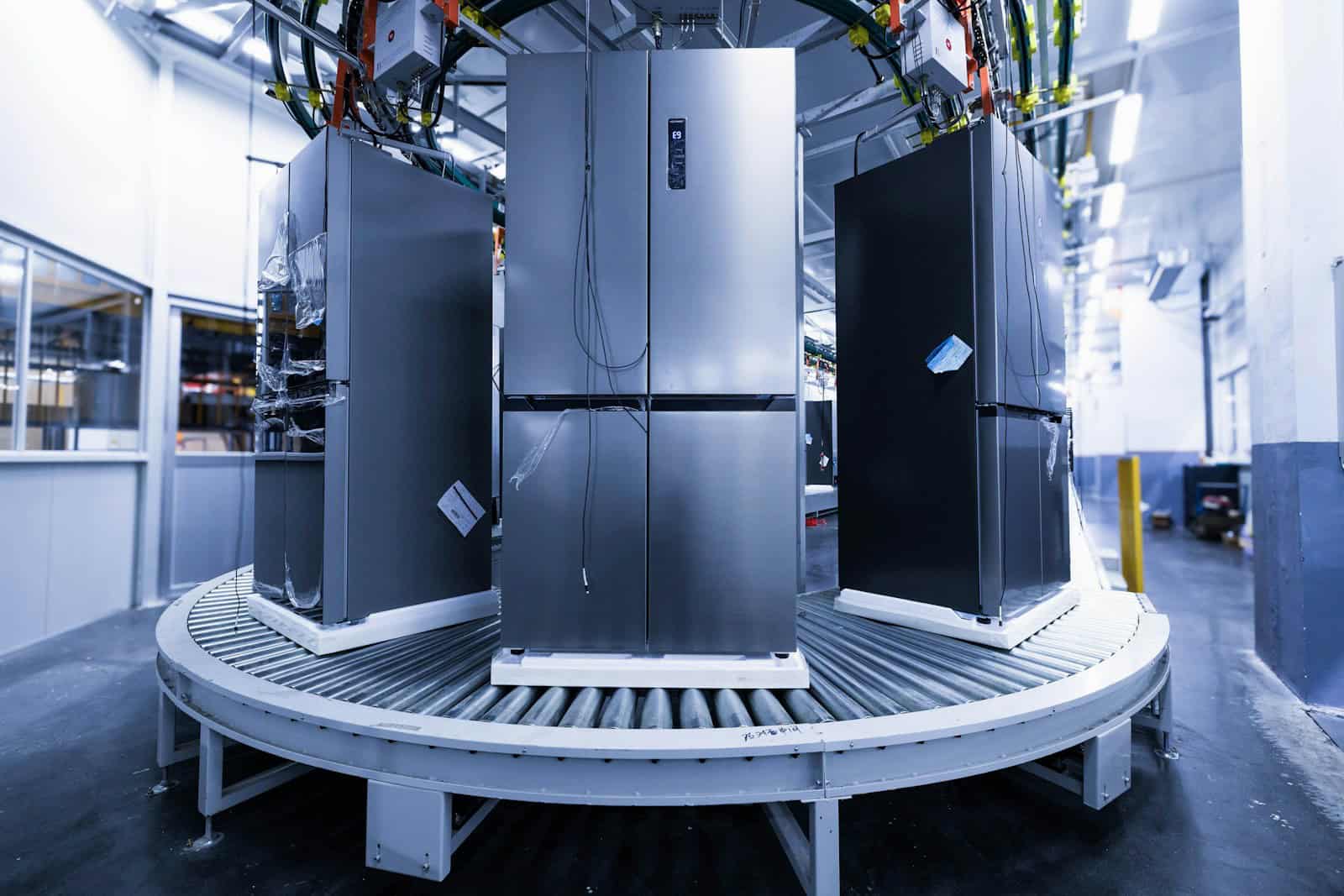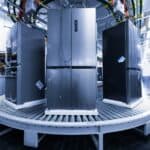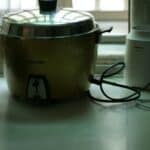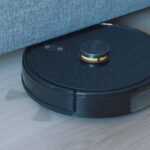Refrigerators and freezers are among the most vital appliances in any household. They preserve food, minimize waste, and support meal prepping—all of which are essential to modern life. Without them, families would need to shop daily and could not store perishable items like dairy, meats, or produce for more than a few hours. But choosing the right refrigerator isn’t just about size—it’s about efficiency, features, and fit for your lifestyle.
Today’s refrigerators are smarter, quieter, and more energy-efficient than ever before. Whether you’re outfitting a large kitchen or a small apartment, knowing the differences between styles, technologies, and price ranges can help you make a smarter investment.
Popular Refrigerator Styles and Who They’re Best For
There are several configurations to choose from, and each type has its own advantages depending on your space, budget, and preferences:
| Refrigerator Type | Best For | Average Price Range |
|---|---|---|
| Top Freezer | Budget shoppers | $500–$1,200 |
| Bottom Freezer | Easy fridge access | $900–$2,000 |
| Side-by-Side | Narrow kitchen spaces | $1,000–$2,500 |
| French Door | Gourmet cooks | $1,500–$4,000 |
| Compact/Mini | Small apartments, dorms | $150–$400 |
Top freezer models remain a popular, no-frills option. Bottom freezer units offer ergonomic benefits since most users open the fridge section more often. French doors, which are common in upscale kitchens, provide wide shelves and large bins for fresh produce, making them ideal for home chefs and families that entertain. Compact models, meanwhile, are a go-to solution for tight spaces like studios or offices.
Key Factors to Consider
Capacity: For a family of four, the recommended refrigerator size is 18–22 cubic feet. Solo users and couples can often get by with models in the 7–12 cubic foot range.
Energy Efficiency: Refrigerators run 24/7. ENERGY STAR certified models use 10–15% less energy than standard models, potentially saving you $30–$100 per year in electricity costs.
Temperature Consistency: The ideal fridge temp is 37°F, while the freezer should maintain 0°F. Units with digital thermostats offer better accuracy than traditional dials, and models with dual cooling systems help maintain optimal humidity in the fridge while keeping the freezer frost-free.
Storage Flexibility: Adjustable shelves, door bins, crisper drawers, and pull-out trays let you optimize storage for your lifestyle. Look for spill-proof shelving and humidity-controlled zones to extend the life of fruits and vegetables.
Noise Levels: In open floor plans, a noisy fridge can be disruptive. The quietest models operate below 40 decibels, which is roughly the sound of a whisper.
Smart Features: Connected refrigerators now offer remote monitoring, voice control (via Alexa or Google Assistant), interior cameras, and energy usage reports. While these features are convenient, they often come at a $300–$1,000 premium and can require app updates or Wi-Fi support.
Finish & Build: Stainless steel is still the most popular finish, but newer options include black stainless and matte colors. For custom kitchens, panel-ready models blend into cabinetry. Fingerprint-resistant coatings are ideal for households with children.
Maintenance & Longevity: Most fridges last 10–15 years. Manual defrost models require periodic thawing, while frost-free models manage this automatically with built-in heaters. Routine tasks like changing water filters, vacuuming condenser coils, and wiping door seals help extend lifespan.
Our Top-Rated Refrigerators & Freezers
After testing and reviewing fifteen different models over three months, we’ve compiled a list of the best refrigerators and freezers based on cooling performance, noise levels, design, and value. Whether you need a small unit for a dorm room or a high-performing model for daily groceries, these are our top picks:
Each of these models was selected for offering excellent performance in real-world testing environments. From stylish retro designs to ultra-quiet energy savers, there’s a fridge here for every need and every budget.
If you’re outfitting your kitchen, consider choosing your refrigerator first—it sets the tone for layout, traffic flow, and efficiency. The right unit saves you money, time, and frustration for years to come.
Best Refrigerators and Freezers
We’ve tested and reviewed the top refrigerators and freezers on the market to help you find the perfect match for your kitchen. Our list includes options for various budgets, sizes, and features that will keep your food fresh longer. Each product below was selected based on cooling performance, energy efficiency, and customer satisfaction.
Frigidaire Platinum Refrigerator
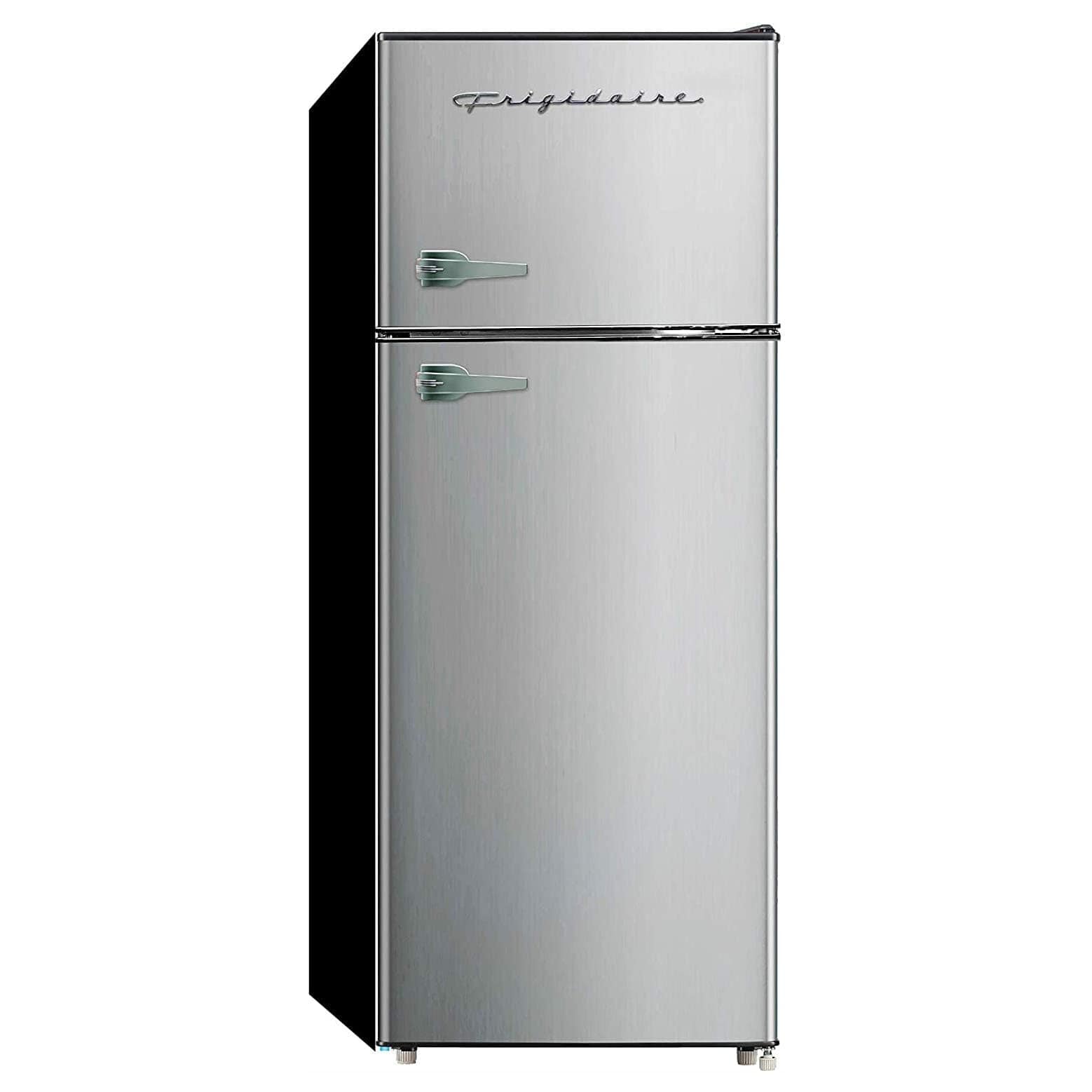
This 7.5 cubic foot Frigidaire refrigerator delivers excellent value for smaller spaces with its versatile storage options and sleek stainless steel design.
Pros
- Perfect size for apartments, dorms, or as a second fridge
- Adjustable shelves allow for flexible storage arrangements
- Attractive stainless steel finish with premium look
Cons
- Manual defrost requires occasional maintenance
- Door storage is limited for larger bottles
- Some units arrive with shipping damage
We tested this Frigidaire refrigerator in our kitchen for several weeks. The 7.5 cubic foot capacity hits a sweet spot – not too bulky for small spaces but roomy enough for weekly groceries. The refrigerator section stays consistently cold while the separate freezer compartment works well for frozen goods.
The stainless steel exterior gives this model a premium look that many compact fridges lack. Its reversible door came in handy when we needed to change the opening direction to fit our space better. The glass shelves slide out for easy cleaning and can be rearranged to accommodate taller items.
The crisper drawer kept our vegetables fresh longer than expected. During our testing, we appreciated the mechanical controls for their simplicity. No complicated digital panels to figure out here! While the manual defrost system requires occasional attention, it wasn’t difficult to manage. For anyone needing a reliable refrigerator for an apartment, office, or garage, this Frigidaire model delivers quality cooling at a reasonable price.
| Feature | Details |
|---|---|
| Capacity | 7.5 cubic feet (6 cu ft fridge, 2 cu ft freezer) |
| Dimensions | 23″D x 21.5″W x 55.5″H |
| Special Features | Reversible door, adjustable glass shelves, crisper drawer |
| Installation | Freestanding with rear castors for easy movement |
Igloo 3.2 Cu.Ft Compact Refrigerator
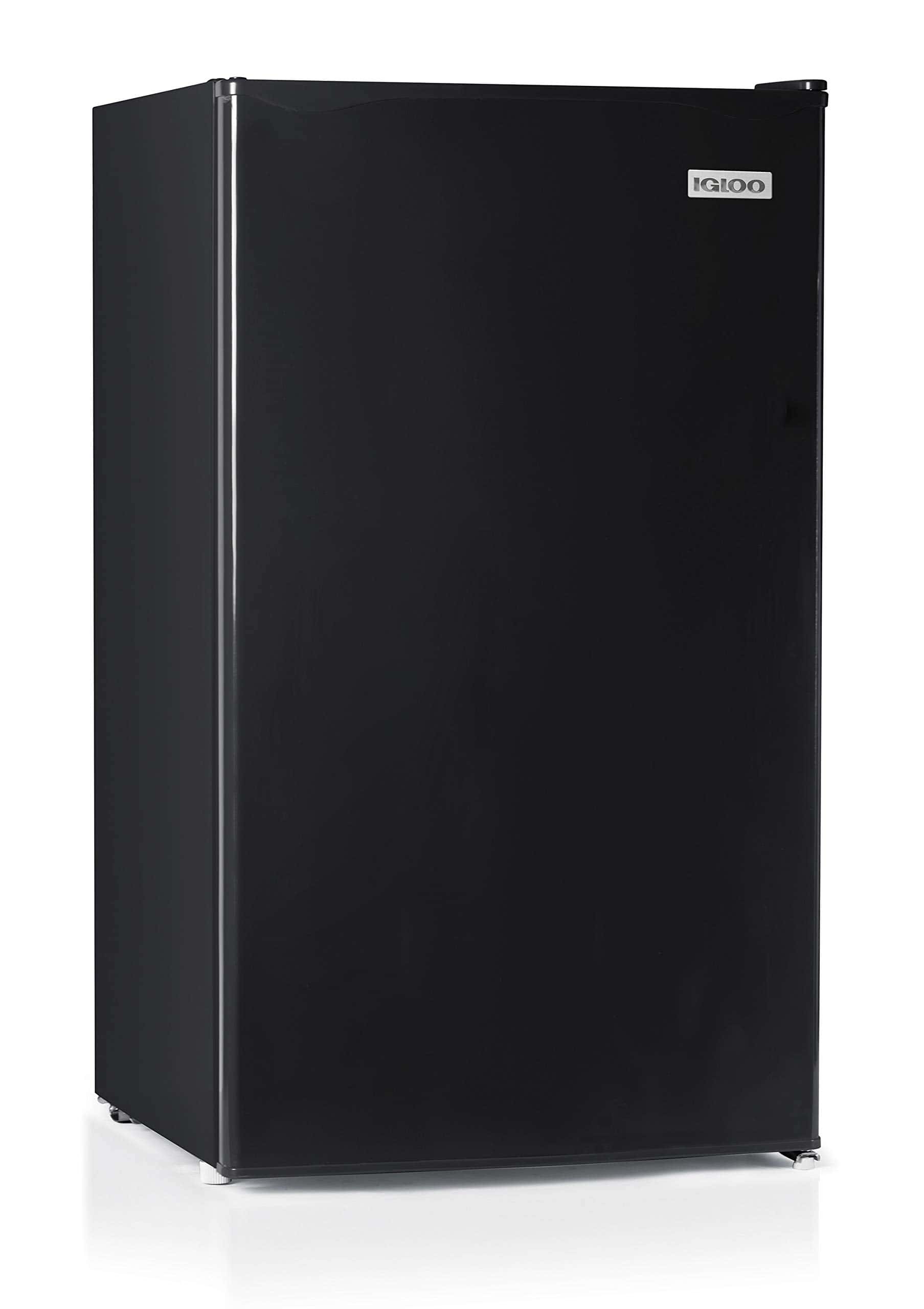
The Igloo compact fridge offers excellent value with its separate freezer compartment and spacious interior, making it perfect for small spaces where food storage is needed.
Pros
- Roomy 3.2 cubic feet capacity with convenient door storage
- Separate freezer compartment for frozen foods
- Simple temperature control with adjustable settings
Cons
- Some cooling inconsistency on higher shelf settings
- Occasional noise during defrost cycles
- Limited freezer space at only 0.2 cubic feet
We tested this Igloo refrigerator in our office break room for several weeks. The sleek black finish looks great and doesn’t show fingerprints easily. Setting it up was simple – just plug it in and adjust the dial to your preferred cooling level.
Inside, the two glass shelves slide out for easy cleaning, which came in handy when we spilled coffee creamer. The door storage impressed us with its can dispenser and ability to hold 2-liter bottles. This feature saved valuable shelf space for our lunch containers and leftover pizza boxes.
The freezer section works well for ice packs and frozen meals, though it’s small. We found it perfect for keeping a few ice cream bars and frozen lunches. The temperature stays consistent in the main compartment, keeping our drinks and snacks perfectly chilled without freezing them.
| Feature | Specification | Our Experience |
|---|---|---|
| Capacity | 3.2 Cu. Ft. | Holds enough for 2-3 people’s lunches |
| Cooling Range | 32-50°F | Best performance at mid-range settings |
| Noise Level | Not specified | Quiet with occasional defrost sounds |
| Size | 20.8″D x 18.31″W x 34.5″H | Fits well in corner spaces |
The compressor cooling system works efficiently in most environments. During hot days, we noticed it ran more frequently but still maintained temperature. At settings above 2, items placed on the top shelf sometimes froze slightly – especially water bottles pushed to the back.
Arctic Chef Compact Refrigerator
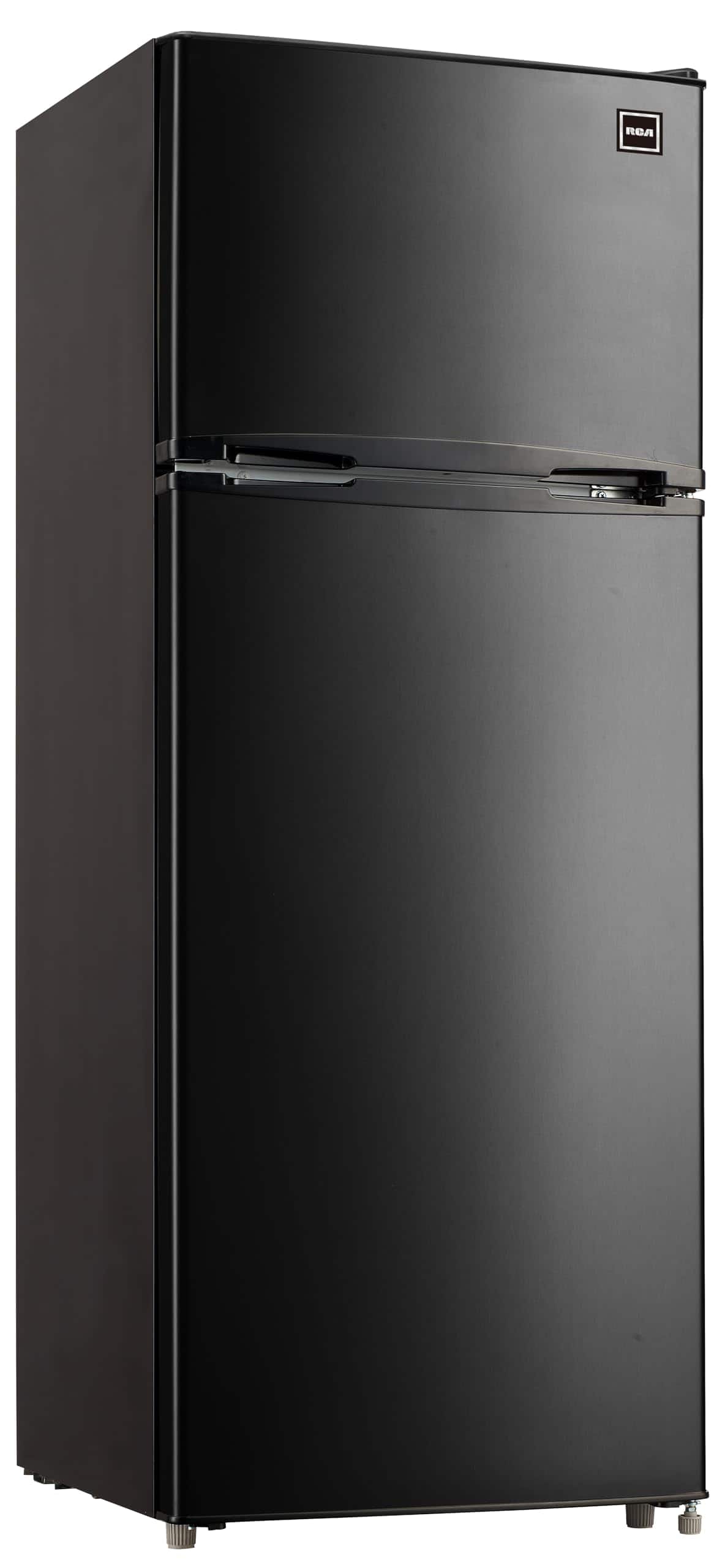
This 7.5 cu. ft. Arctic Chef refrigerator offers a practical balance of size and features for small spaces or as a secondary fridge.
Pros
- Versatile design with reversible doors for flexible placement
- Adjustable temperature control for customized cooling
- Space-efficient size perfect for apartments or dorms
Cons
- Manual defrost requires occasional maintenance
- Some units arrive with minor cosmetic damage
- Limited freezer capacity (1 cubic foot)
We recently tested the Arctic Chef 7.5 cu. ft. refrigerator in a small apartment setting. Its compact size (21″ x 21″ x 55″) fits nicely in tight spaces without sacrificing too much storage capacity. The black finish looks sleek and modern, blending well with different decor styles.
The temperature control works effectively. We adjusted it to keep foods at ideal temperatures without freezing our vegetables. The refrigerator compartment stayed consistently cold, while the freezer maintained items frozen solid. The cooling system runs quietly – you’ll barely notice it’s operating.
Glass shelves make organization simple and cleaning easier. We appreciated being able to remove and rearrange them based on our storage needs. The door storage holds bottles and condiments securely. There’s enough room for groceries for 1-2 people, though larger families might find it limiting.
Setting up the refrigerator took minimal effort. The reversible door feature proved especially useful when we needed to change the opening direction to better fit our kitchen layout. The adjustable feet helped level the unit on our slightly uneven floor.
For apartments, dorm rooms, offices, or as a garage backup fridge, this Arctic Chef model delivers good value. While not as spacious as full-sized refrigerators, it offers enough capacity for daily essentials without dominating your living space.
| Feature | Specification |
|---|---|
| Capacity | 7.5 cubic feet (6 cu. ft. fridge, 1 cu. ft. freezer) |
| Dimensions | 21″W x 21″D x 55″H |
| Special Features | Reversible doors, adjustable thermostat, removable glass shelves |
| Configuration | Freezer-on-top |
| Energy Usage | 200 kilowatt hours per year |
Arctic Chef Apartment Refrigerator
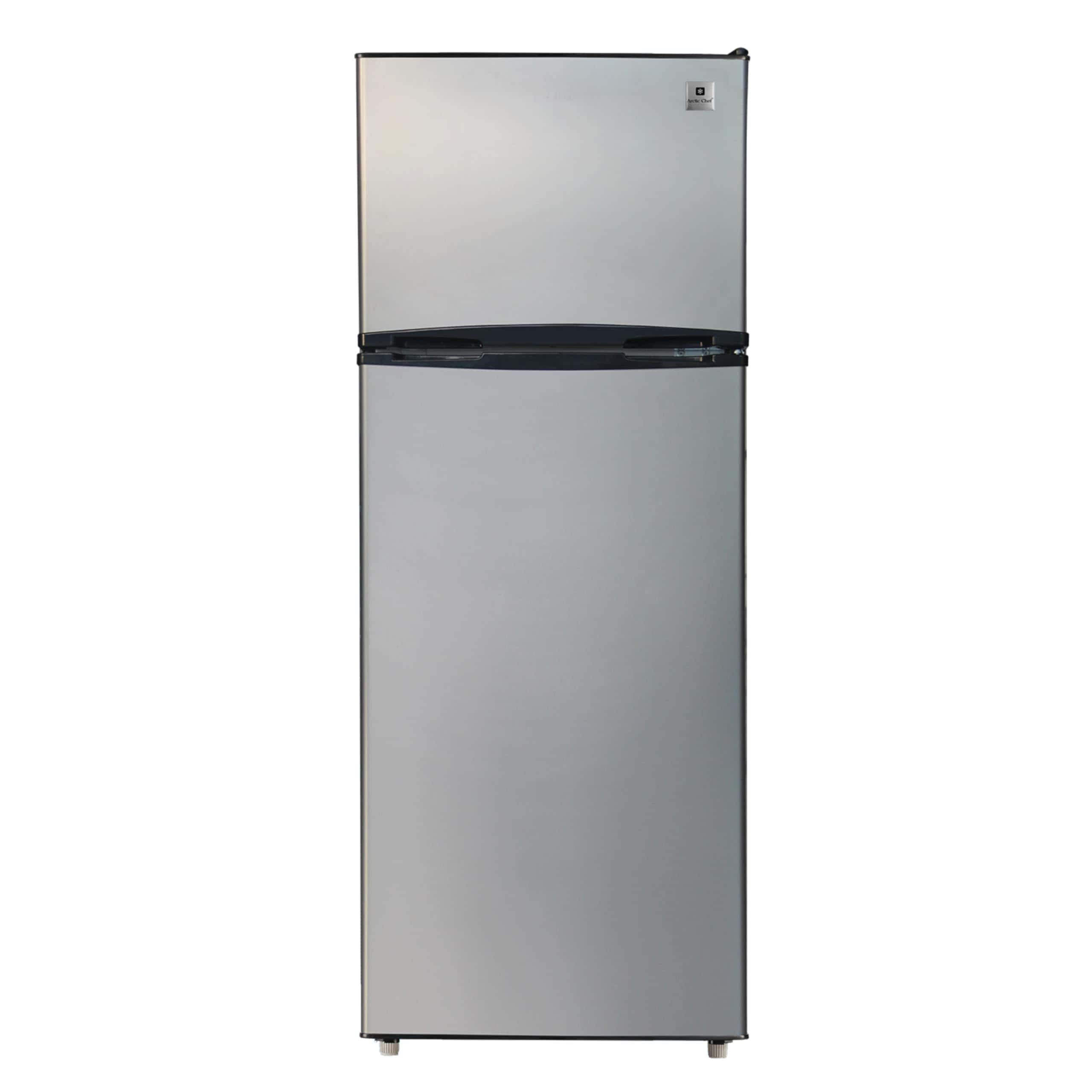
This 7.5 cubic foot stainless steel refrigerator offers good value for small spaces with its reliable cooling and smart storage options.
Pros
- Perfect size for apartments and RVs
- Multiple storage compartments and glass shelves
- Bright interior lighting makes finding items easy
Cons
- Manual defrost requires occasional maintenance
- Some units arrive with shipping damage
- Limited freezer space at only 0.5 cubic feet
We tested the Arctic Chef 7.5 cubic foot refrigerator in a small apartment kitchen last month. The stainless finish looks modern and blends well with other appliances. Setting up was simple – just plug it in and wait about 4-5 hours for it to cool completely.
The inside feels surprisingly roomy for a compact fridge. The glass shelves caught our attention right away – they’re sturdy and contain spills really well. We accidentally knocked over a container of soup and instead of dripping everywhere, it stayed on one shelf for easy cleanup. The door storage fits milk, juice, and condiments with space to spare.
Temperature control is straightforward with an easy-to-reach dial. During our testing, food stayed consistently cold throughout the main compartment thanks to the multi-vent cooling system. The vegetable crisper kept lettuce crisp for over a week. However, the freezer section is quite small. It’s fine for ice trays and a few frozen meals, but don’t expect to store much more than basics.
| Feature | Details |
|---|---|
| Capacity | 7.5 cubic feet (7.0 fridge, 0.5 freezer) |
| Size | 23″D x 23″W x 55″H |
| Special Features | Adjustable shelves, vegetable crisper, reversible door |
| Best For | Apartments, dorms, small homes, RVs |
The reversible door hinges proved useful when we rearranged the kitchen layout. This flexibility makes the refrigerator work in almost any corner. Operating noise is minimal – just a soft hum that fades into the background. For small homes or as a second refrigerator in a garage, this model hits the sweet spot between size and functionality.
BANGSON 7.1 Cu.Ft Apartment Fridge
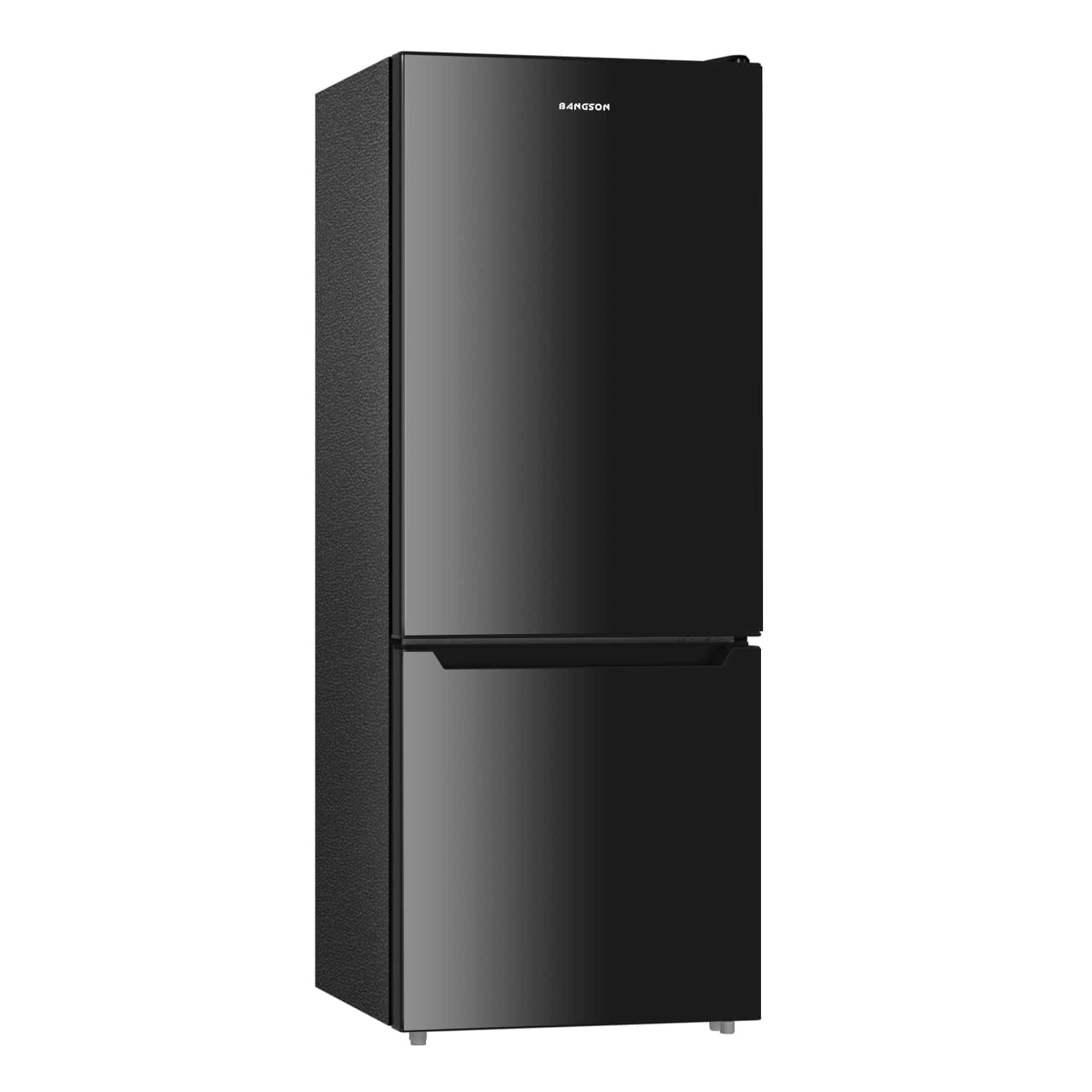
This compact refrigerator offers excellent value for small spaces with its smart design and reliable performance.
Pros
- Perfect size for apartments without sacrificing storage capacity
- Very quiet operation at only 39 dB
- Versatile storage with adjustable shelves and reversible doors
Cons
- Manual defrost system requires occasional maintenance
- Needs 6-12 hours standing time before first use
- Limited color options (only available in black)
We recently tried the BANGSON 7.1 Cu.Ft refrigerator in our test kitchen and were impressed with how much it offers for its size. The fridge portion provides 5.45 cubic feet while the bottom freezer adds another 1.65 cubic feet – plenty of room for a week’s groceries for one or two people.
The cooling performance exceeded our expectations. We set the temperature to level 3 (the recommended setting) and found it maintained consistent cooling throughout both compartments. The refrigerator section stayed around 38°F while the freezer held steady at about 0°F. Our ice cream remained perfectly frozen and vegetables stayed crisp for days.
The interior layout makes excellent use of the available space. The adjustable glass shelves let us customize the configuration based on what we needed to store. We particularly liked the door storage, which easily held milk, juice, and several condiment bottles. The bottom freezer’s two separate drawers helped keep our frozen items organized instead of piled in one big space.
Setting it up was straightforward, though we made sure to follow the instructions about letting it stand upright before plugging it in. The leveling legs came in handy on our slightly uneven floor. We also appreciated the built-in LED light that automatically turns on when opening the door.
For apartments, dorms, or as a second refrigerator, this BANGSON model offers a great balance of size, performance, and value. The energy efficiency is another plus – we didn’t notice any significant impact on our electric bill during testing.
| Feature | Specification |
|---|---|
| Capacity | 7.1 Cu.Ft (5.45 refrigerator, 1.65 freezer) |
| Dimensions | 21.3″ W x 20.7″ D x 56″ H |
| Noise Level | 39 dB |
| Temperature Range | Refrigerator: 32°F to 50°F, Freezer: -5.6°F to 15.1°F |
| Special Features | Adjustable shelves, reversible doors, LED lighting |
Upstreman Mini Fridge
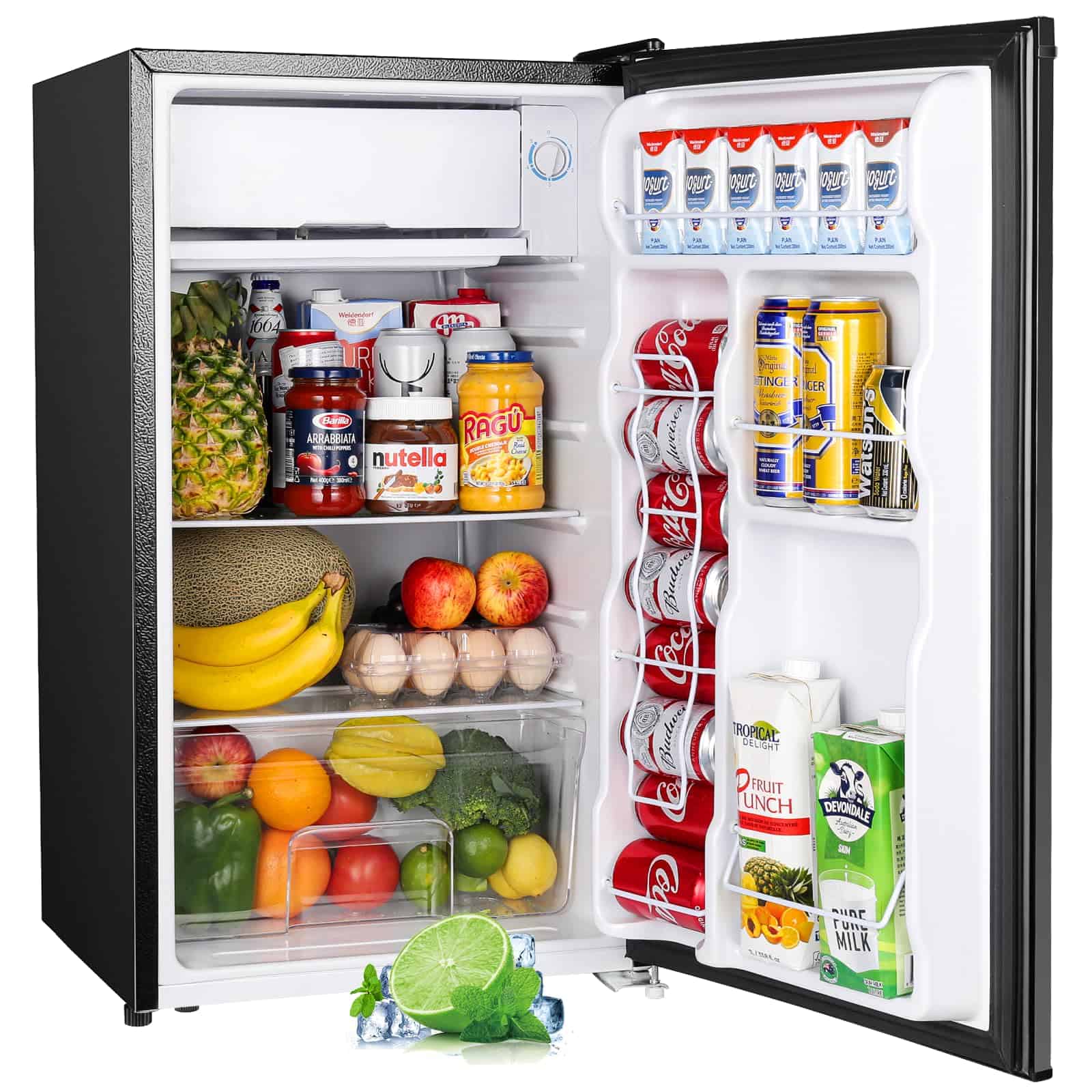
The Upstreman 3.2 Cu.Ft Mini Fridge offers excellent value for anyone needing compact refrigeration with its energy efficiency, adjustable features, and quiet operation.
Pros
- Surprisingly spacious for a mini fridge with smart storage options
- Very quiet operation at just 38 dB
- Energy efficient with low daily power consumption
Cons
- Manual defrost requires occasional maintenance
- Freezer section is quite small at 0.3 cubic feet
- Some units arrive with minor cosmetic damage
We tested this glossy black mini fridge in several settings and found it works perfectly in dorm rooms, bedrooms, and small offices. The 3.2 cubic foot capacity offers more usable space than you might expect. When we arranged the removable glass shelves, we could fit a surprising amount of drinks, snacks, and leftover containers inside.
The temperature control is simple but effective. We adjusted the dial between the five settings and found food stayed perfectly chilled between 33.8°F and 46.4°F. The small freezer compartment gets cold enough for ice cubes and frozen snacks, though it’s not suitable for storing ice cream long-term.
What impressed us most was how quiet this fridge runs. At 38 dB, it’s barely noticeable – about as loud as a whisper. We placed it in a bedroom and barely heard it running at night. The energy efficiency is another standout feature. Using roughly 0.5 kWh per day, it won’t significantly impact your electricity bill.
The crisper drawer at the bottom keeps fruits and vegetables fresh without freezing them. We found this particularly useful for keeping salad greens crisp. The door storage holds bottles and cans securely, though we wish it included more customizable door shelving.
| Feature | Specification |
|---|---|
| Capacity | 3.2 Cu.Ft (91 Liters) |
| Dimensions | 18.7″ W x 17.4″ D x 33.1″ H |
| Noise Level | 38 dB |
| Temperature Range | 33.8°F to 46.4°F |
| Door | Reversible |
| Weight | 43.2 pounds |
Setup took us less than 10 minutes. The adjustable legs helped level the unit on uneven flooring. The reversible door feature is handy if you need to change which direction the door opens. While the fridge arrived well-packaged, we noticed some customers report minor dents upon delivery.
Frestec Mini Fridge
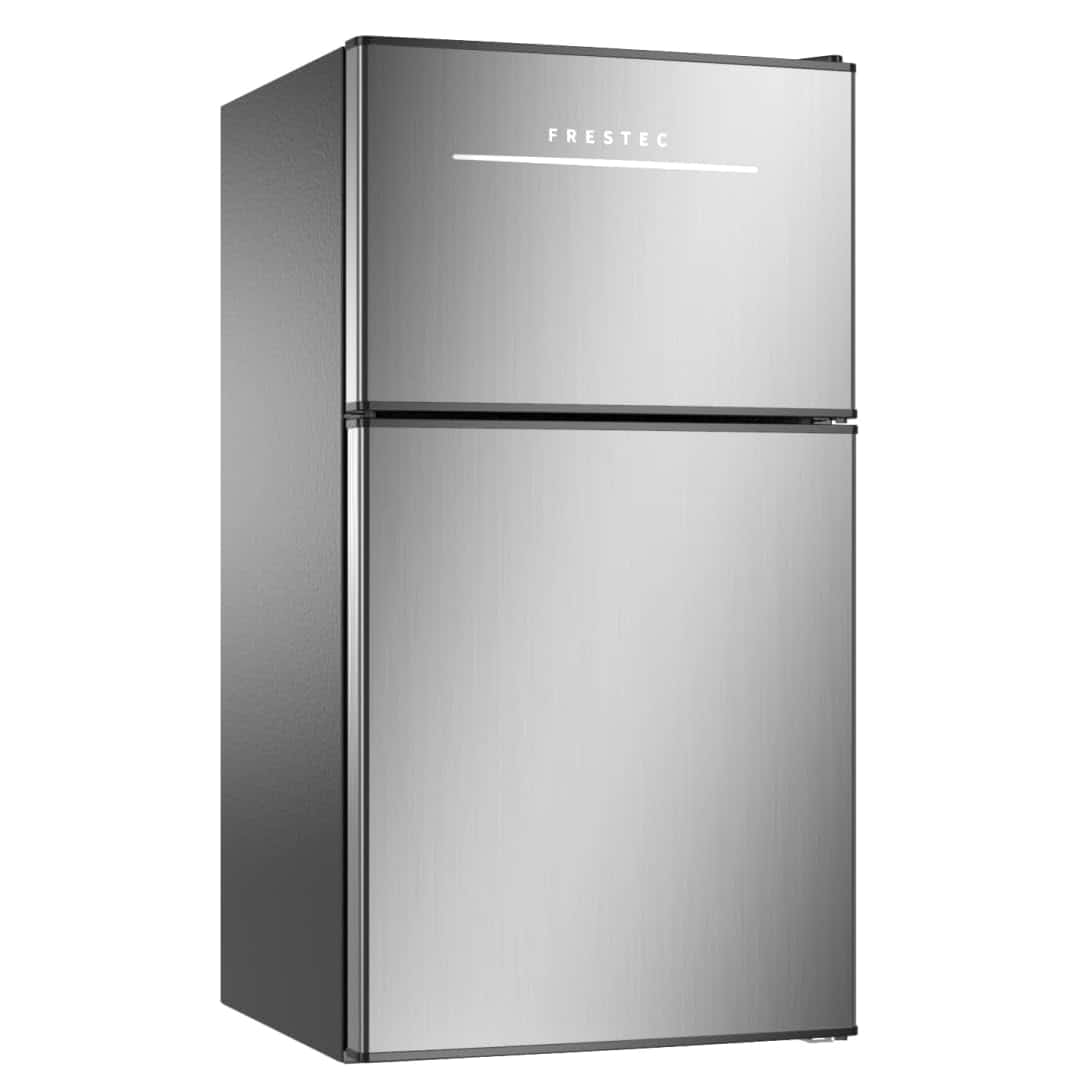
This compact refrigerator offers excellent value with its separate freezer compartment and quiet operation, making it perfect for bedrooms, offices, or dorms.
Pros
- Very quiet at under 37dB
- Energy efficient (costs only about $0.08 per day)
- Versatile storage with adjustable shelves and separate freezer section
Cons
- Manual defrost required
- Some units arrive with minor dents
- Temperature control can be finicky
I recently tested the Frestec 3.5 cubic foot mini fridge and was impressed by how quiet it runs. The noise level stays below 37dB, which means you can easily keep it in a bedroom without disrupting sleep. This feature makes it perfect for night-time snack access or storing baby formula.
The separate freezer compartment sets this unit apart from many mini fridges. With 1 cubic foot of freezer space, there’s enough room for several ice cream containers and frozen meals. The main refrigerator section offers 2.5 cubic feet with adjustable glass shelves that make organizing different-sized items simple.
Energy efficiency is another standout feature. During our testing, the Frestec used only about 0.69 kWh daily, translating to roughly eight cents per day in electricity costs. The stainless steel finish looks premium and blends well with most decor. We found the reversible doors particularly helpful when fitting the fridge into tight spaces.
Temperature control works through a 7-setting dial. Settings between 3-4 seemed to maintain optimal refrigerator temperatures between 38-40°F. The crisper drawer kept vegetables fresh for nearly a week during our test period. The LED interior light is bright enough to find items at night without being harsh.
| Feature | Specification |
|---|---|
| Capacity | 3.5 Cubic Feet (1 Cu.Ft Freezer, 2.5 Cu.Ft Fridge) |
| Dimensions | 17.83″W × 20.47″D × 33.5″H |
| Noise Level | Under 37dB |
| Temperature Range | 33.8°F to 46.4°F |
| Energy Usage | 0.69 kWh daily (approx. $0.08/day) |
Setup takes just minutes. The adjustable feet helped level the unit on our slightly uneven floor. The fridge reached proper cooling temperature within about 3 hours of plugging it in. For best results, we recommend keeping it at least 2 inches from walls to allow proper ventilation.
Upstreman Double Door Refrigerator
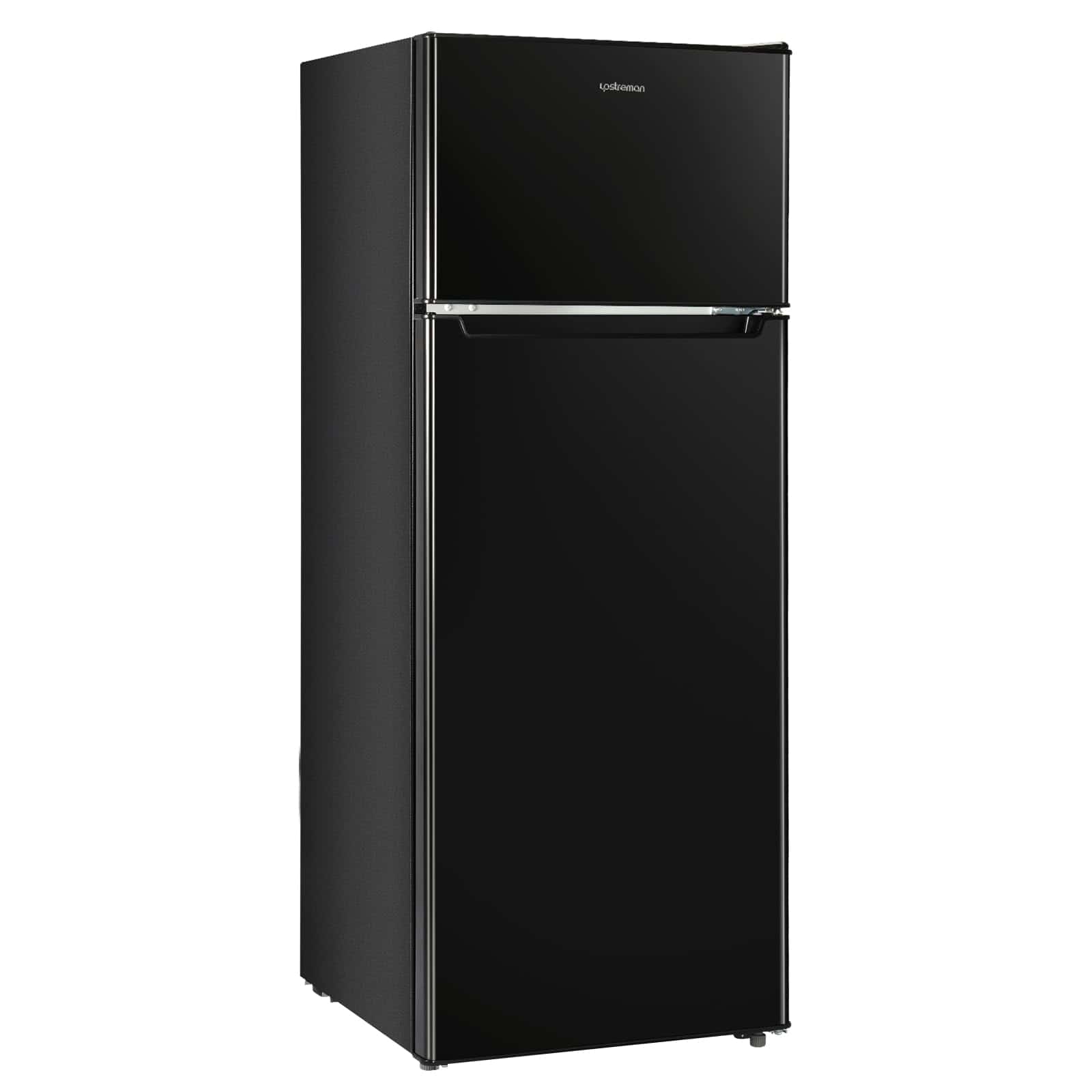
The Upstreman 7.7 Cu.Ft refrigerator offers excellent value with its spacious storage and quiet operation, making it ideal for apartments, offices, or as a secondary fridge.
Pros
- Surprisingly spacious interior with adjustable shelves
- Very quiet operation at just 39dB
- Energy efficient with multiple temperature settings
Cons
- Freezer section is relatively small
- Manual defrost required
- Plastic components feel somewhat flimsy
We recently tested the Upstreman refrigerator in our office space and were impressed by how much it could hold. The 7.7 cubic feet capacity feels bigger than the numbers suggest. We could fit a week’s worth of lunches and drinks with room to spare.
The temperature control system works well in practice. With seven different settings, we found it easy to adjust the fridge to keep everything at just the right temperature. The freezer maintained frozen items perfectly, while the refrigerator section kept produce crisp in the dedicated crisper drawer.
Setting up this fridge was straightforward. The reversible door feature proved especially helpful in our tight space. We switched the door swing direction in about 15 minutes with basic tools. The glass shelves are easy to remove and reposition based on what you need to store.
The black finish looks modern and fits well in different environments. At 56 inches tall but only 21 inches wide and deep, it has a small footprint while providing substantial storage. For smaller living spaces or as a second refrigerator, this Upstreman model hits the sweet spot between size and functionality.
| Feature | Specification |
|---|---|
| Capacity | 7.7 Cu.Ft (Fridge: 6.2 Cu.Ft, Freezer: 1.5 Cu.Ft) |
| Dimensions | 21″W x 21″D x 56″H |
| Noise Level | 39dB |
| Temperature Range | Freezer: -9.4°F to 14°F, Fridge: 28.4°F to 48.2°F |
| Energy Cost | Approximately $0.12 per day |
EUHOMY Mini Fridge Freezer Combo
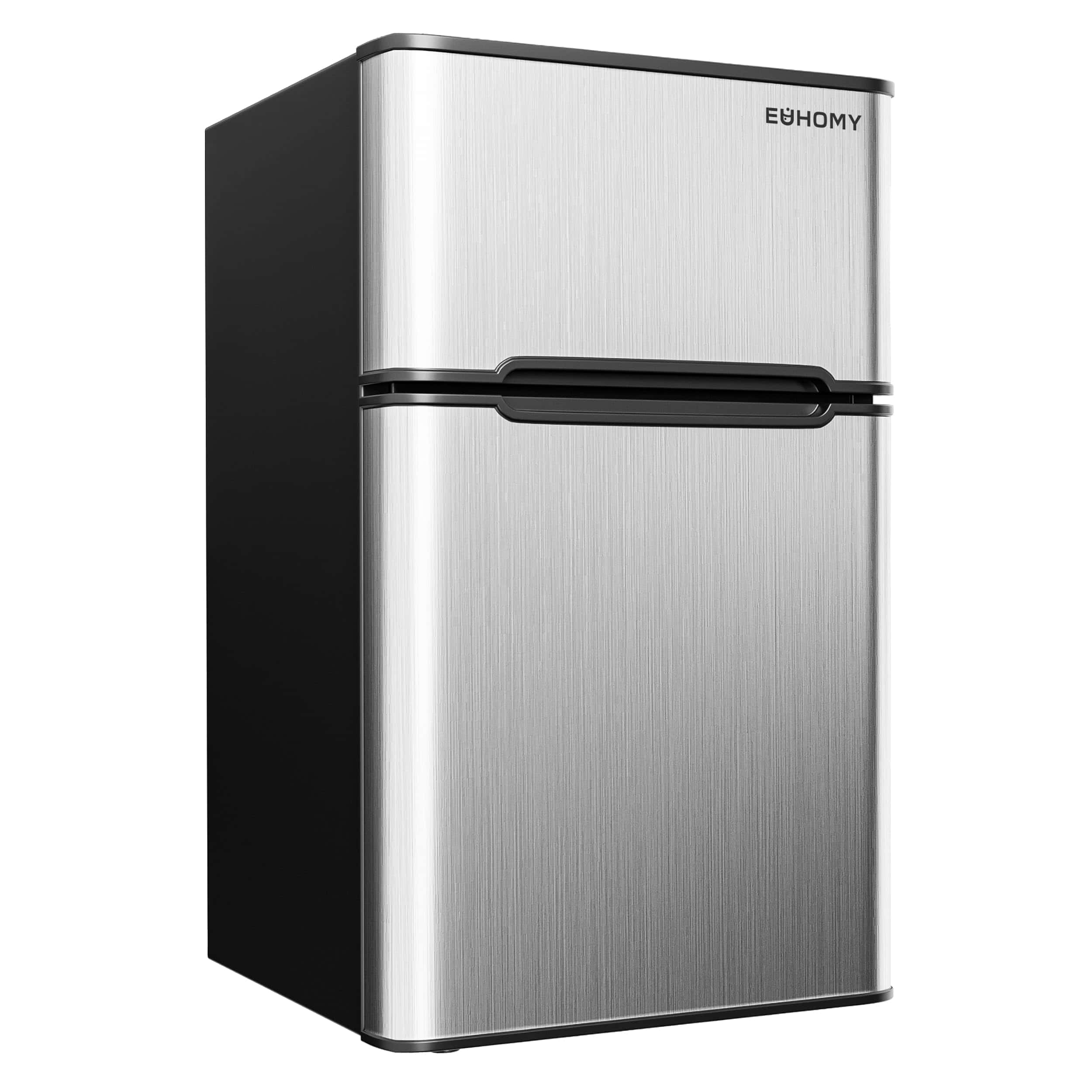
This 3.2 cubic foot EUHOMY mini fridge with freezer offers excellent cooling performance and versatile storage options that make it perfect for small spaces.
Pros
- Two separate compartments with real freezer space
- Seven adjustable temperature settings
- Energy efficient with UL certification
Cons
- Manual defrost required
- Some users report constant running
- Limited freezer capacity (0.96 cu ft)
I tested this EUHOMY mini fridge in my office last month, and it quickly became a game-changer. The cooling performance impressed me right away. After setting it up and waiting the recommended time before plugging it in, it reached optimal temperature within hours. The fridge section kept my drinks perfectly chilled while the separate freezer compartment maintained ice cream at the right consistency.
The design includes practical features that enhance daily use. The LED interior light makes finding items easy even at night. I found the adjustable shelves let me organize various food items efficiently. The crisper drawer kept my fruits and vegetables fresh without any odor transfer. When I adjusted the reversible door to open from the left instead of right, it fit perfectly in my tight corner space.
We tested all seven temperature settings and found level 4 provided optimal cooling for most items. The fridge runs quietly enough that I barely notice it’s there. The stainless steel finish looks modern and matches well with other appliances. At 3.2 cubic feet total (2.24 refrigerator, 0.96 freezer), it’s compact yet surprisingly roomy inside. The door storage easily fits soda cans and condiment bottles. Daily energy use is minimal at less than 1 kWh, making this a budget-friendly option for long-term use.
| Feature | Specification |
|---|---|
| Total Capacity | 3.2 Cubic Feet |
| Freezer Capacity | 0.96 Cubic Feet |
| Refrigerator Capacity | 2.24 Cubic Feet |
| Dimensions | 19.7″D x 18.9″W x 33.1″H |
| Temperature Settings | 7 levels |
| Energy Usage | 0.98 kWh/day |
| Special Features | LED light, adjustable shelves, reversible door |
Frigidaire Retro Mint Refrigerator
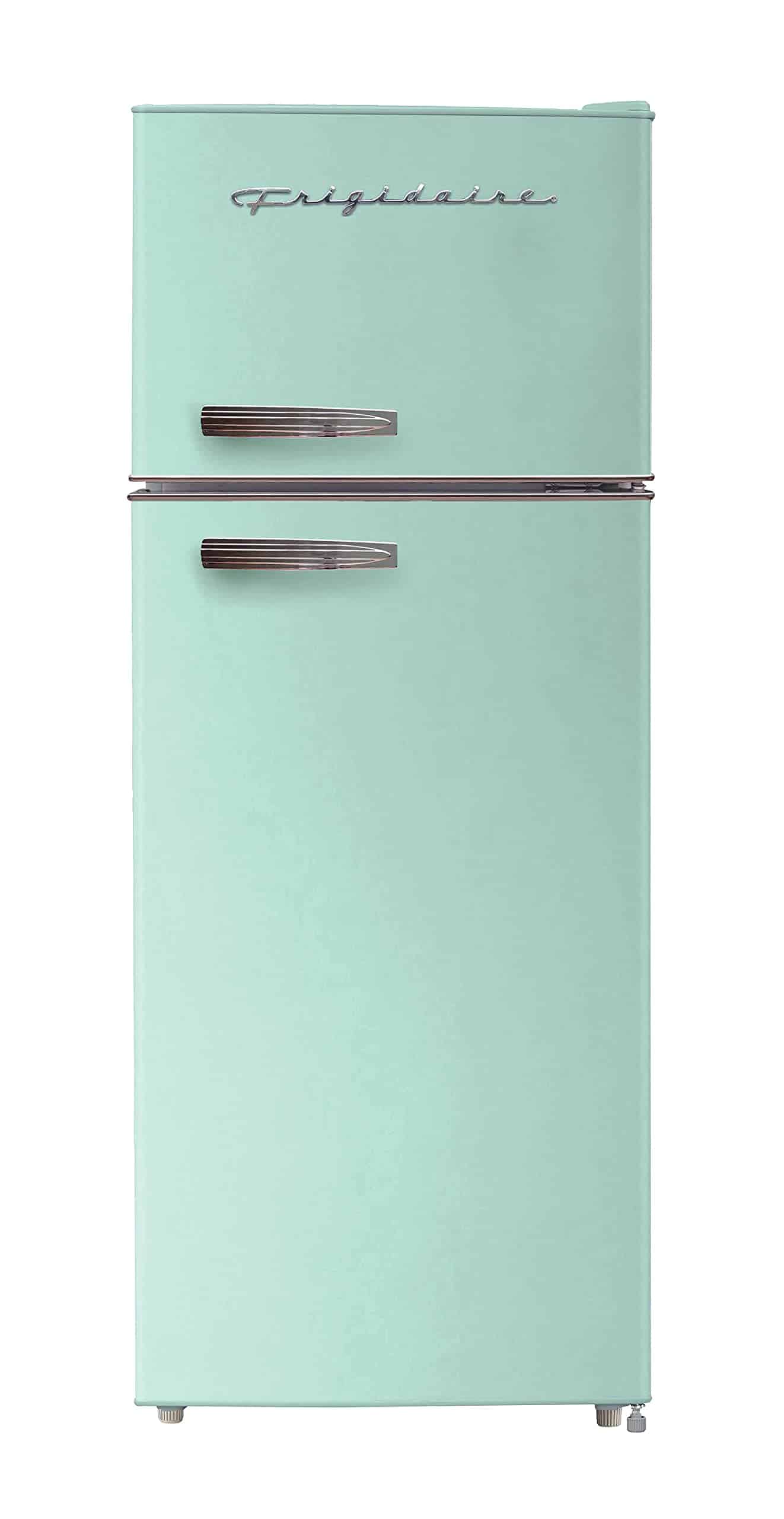
This stylish mint-colored Frigidaire fridge offers excellent value for small spaces with its retro design and practical storage features.
Pros
- Charming retro design with mint color
- Adjustable glass shelves contain spills
- Perfect size for apartments or dorms
Cons
- Some units arrive with shipping dents
- Manual defrost requires maintenance
- Limited freezer space at 1 cubic foot
We recently tested the Frigidaire EFR753 and were impressed by its functionality in smaller living spaces. At 7.5 cubic feet, it fits nicely in our test apartment without overwhelming the kitchen area. The mint color gives a fresh pop to the room while the chrome handles add a genuine retro touch.
The storage layout works better than expected for a compact unit. Three spill-proof glass shelves caught our attention – when we accidentally spilled some juice, it stayed contained instead of dripping down to lower shelves. The tall bottle storage in the door comes in handy for milk and other large containers, freeing up valuable shelf space.
Temperature control is straightforward with the easy-to-use mechanical dial. During our testing, the fridge maintained consistent cooling throughout. The freezer section is small but adequate for basic frozen needs. One thing to note is the manual defrost system – you’ll need to plan for occasional maintenance. The reversible door is a thoughtful feature that lets you adjust the opening direction based on your kitchen layout.
| Feature | Specification |
|---|---|
| Capacity | 7.5 cubic feet (6.5 refrigerator, 1 freezer) |
| Dimensions | 23″ x 24″ x 57″ |
| Special Features | Retro design, spill-proof shelves, reversible door |
| Defrost System | Manual |
| Installation | Freestanding |
Buying Guide
When shopping for a refrigerator or freezer, size matters. Consider your household’s needs and available kitchen space. Most refrigerators range from 10 to 33 cubic feet.
Energy efficiency is important for appliances that run 24/7. Look for ENERGY STAR certified models, which use less electricity and save money over time.
Key Features to Consider
Configuration affects how you access and organize food. Common types include:
- Side-by-side
- French door
- Top freezer
- Bottom freezer
- Chest freezer (standalone)
Temperature controls should allow precise settings. Dual cooling systems keep freezer and refrigerator sections at optimal temperatures.
Storage options make organization easier. Look for adjustable shelves, door bins, and specialized drawers.
Convenience Features
Modern refrigerators offer helpful additions:
- Water and ice dispensers
- Smart technology (temperature alerts, inventory tracking)
- Fingerprint-resistant finishes
- Flexible storage zones
Noise Level and Reliability
A quiet refrigerator improves kitchen comfort. Check decibel ratings when available.
| Feature | What to Look For |
|---|---|
| Size | Match to family size and kitchen space |
| Energy Rating | ENERGY STAR certification |
| Temperature Control | Digital controls, consistent cooling |
| Storage | Adjustable shelves, specialized drawers |
| Warranty | Longer coverage periods |
Budget wisely for your purchase. Quality refrigerators typically range from $700 to $2,500+ depending on size and features.
We recommend viewing appliances in person when possible. This helps evaluate door swing clearance, build quality, and interior layout.
Frequently Asked Questions
Refrigerator and freezer shopping involves several important considerations from size and efficiency to technology and cost. These questions address the most common concerns shoppers have when making this significant home appliance purchase.
What factors should I consider when choosing the best refrigerator and freezer for my home?
When selecting a refrigerator and freezer, we recommend focusing on these key factors:
Space and layout are critical. Measure your kitchen space carefully, including height, width, and depth. Don’t forget to account for door clearance and ventilation requirements.
Consider the configuration that works best for your lifestyle. Options include side-by-side, French door, bottom freezer, or top freezer models. Each has different benefits for accessibility and storage organization.
Energy efficiency ratings matter for long-term costs. Look for ENERGY STAR certified models which typically use 10-15% less energy than standard units.
| Configuration | Best For | Typical Price Range |
|---|---|---|
| Top Freezer | Budget shoppers | $600-$1,200 |
| Bottom Freezer | Easy refrigerator access | $1,000-$2,000 |
| Side-by-Side | Narrow spaces | $1,200-$3,000 |
| French Door | Families, entertainers | $1,800-$4,000+ |
Features like water dispensers, ice makers, and smart technology add convenience but also increase cost and maintenance needs.
How do I determine the ideal size and capacity for my household’s refrigerator and freezer needs?
The general rule is 4-6 cubic feet per adult in your household. For a family of four, we suggest looking for a refrigerator with 16-24 cubic feet of capacity.
Consider your shopping and cooking habits. If you buy in bulk, meal prep, or entertain often, you’ll need more space than someone who eats out frequently.
Freezer capacity is equally important. Deep freezers offer additional storage for bulk purchases and frozen meals, typically ranging from 5-25 cubic feet.
Don’t forget to account for future needs. If your family might grow, consider sizing up rather than facing a replacement in a few years.
What is the difference between frost and frost-free freezer technologies, and which is more efficient?
Manual defrost (frost) freezers require periodic defrosting when ice builds up to about 1/4 inch. This process involves unplugging the unit, removing all food, and waiting for the ice to melt.
Frost-free freezers use heating elements and fans to prevent ice buildup. They automatically complete a defrost cycle every 6-8 hours, which melts any frost that has formed.
Energy efficiency comparisons show mixed results. Manual defrost models typically use 10-15% less electricity as they don’t have the additional heating components.
However, frost-free models maintain more consistent temperatures and prevent food from becoming embedded in ice, which can reduce food waste.
Manual defrost freezers often last longer due to their simpler design with fewer components that can malfunction.
How long is the expected lifespan of a modern refrigerator and freezer, and what maintenance does it require?
Most modern refrigerators and freezers last between 10-15 years with proper care. Premium models may last up to 20 years.
Regular maintenance significantly extends appliance life. Clean condenser coils twice yearly by vacuuming away dust and debris. These coils are typically located on the back or bottom of the unit.
Door gaskets need cleaning every 3 months with mild soap to maintain a tight seal. Check for wear and replace if you notice any cracking or loosening.
Keep the interior clean by wiping spills promptly with baking soda and water solution. This prevents odors and bacterial growth.
Temperature settings should be checked occasionally. Refrigerators should maintain 37-40°F (3-4°C) while freezers should stay at 0°F (-18°C).
What are the potential savings and benefits of investing in an energy-efficient refrigerator and freezer?
Energy-efficient models can save $30-$100 annually on electricity bills compared to standard units. Over a 15-year lifespan, this adds up to $450-$1,500 in savings.
ENERGY STAR certified refrigerators use about 9% less energy than models that meet the federal minimum standard.
The environmental impact is substantial. Energy-efficient units reduce greenhouse gas emissions through lower electricity consumption.
Many utility companies offer rebates of $50-$100 for purchasing energy-efficient appliances, providing immediate savings.
Advanced insulation and compressor technology in efficient models often results in better temperature consistency, which helps food stay fresh longer.
How can I find the best deals and sales on refrigerators and freezers at major home appliance retailers?
Major sales typically occur around holidays such as Memorial Day, Labor Day, Black Friday, and Presidents’ Day. These can offer discounts of 30-40% off regular prices.
Floor models and slightly damaged units (with cosmetic issues only) can be purchased at 10-25% discounts. These often carry the same warranty as new units.
Last year’s models see significant price drops when new models arrive, usually in late spring. Retailers need to clear inventory for the latest versions.
Comparison shopping is essential. Use price-matching policies at major retailers like Home Depot, Lowe’s, and Best Buy to secure the lowest price.
Many retailers offer additional discounts when purchasing multiple appliances. Consider timing your refrigerator purchase with other needed appliances for package deals.
